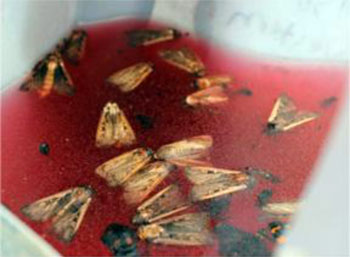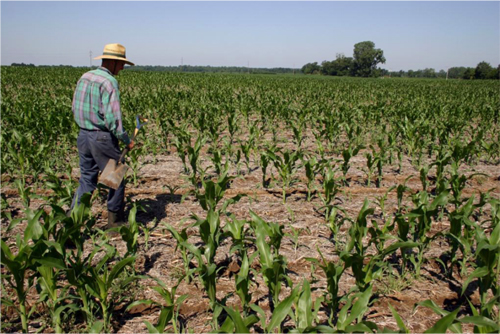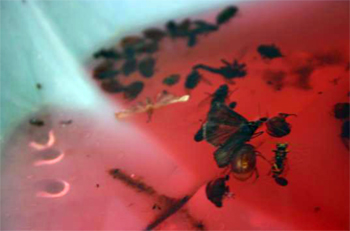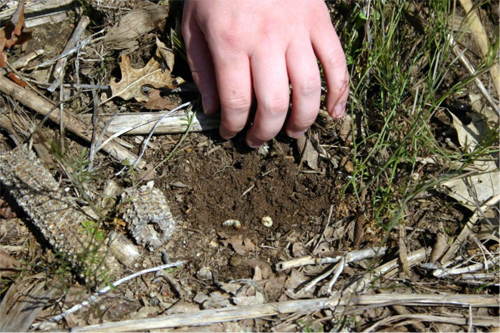Asiatic garden beetle larval feeding was more widespread in southwest Michigan in 2011
How to determine if your corn field is at risk of Asiatic garden beetles in 2012.
 Bt corn varieties and seed treatments have changed how most producers view early season insect control. However, it is important not to overlook a relatively new pest to southwest Michigan, the Asiatic garden beetle. The larval stage of the pest, a white grub similar in appearance to Japanese beetle larvae, can pack a much more serious punch to rotated corn stands when compared to their more common cousins.
Bt corn varieties and seed treatments have changed how most producers view early season insect control. However, it is important not to overlook a relatively new pest to southwest Michigan, the Asiatic garden beetle. The larval stage of the pest, a white grub similar in appearance to Japanese beetle larvae, can pack a much more serious punch to rotated corn stands when compared to their more common cousins.
Detecting white grub populations has never been an easy task. Unless you happen to observe the beetles when they are laying eggs in a soybean or alfalfa field, there is not any reason to suspect that the field would have excessive numbers of white grubs the following spring. However, we do have a couple of tools to use to detect Asiatic garden beetle adults. One way to monitor for the number of adults in your area is to observe dead beetle carcasses around brightly lit canopies and ornamental plantings. Elevated numbers can lead to a greater chance of Asiatic garden beetle white grub feeding damage.
|
Another way we have been finding Asiatic garden beetle incidence is in western bean cutworm moth traps. We have been catching increasing levels of Asiatic garden beetle in western bean cutworm traps in many locations across southwest Michigan. We use RV anti-freeze in our western bean cutworm pheromone traps, and adult beetles seem to be attracted to the material. We first noticed this potential when we began trapping for western bean cutworms in St. Joseph County, Mich., in 2008. Since that time, traps in Van Buren, Allegan, Kalamazoo, Cass and Berrien counties have been catching low numbers of Asiatic garden beetles. The number of Asiatic garden beetles began to rise in St. Joseph County in 2010, and we found elevated numbers of beetles caught in Van Buren County and along the Allegan County border in 2011. These are simply observations of the pests; there is not a threshold developed from this method of observation. However, we did see an increase in Asiatic garden beetle feeding damage in St. Joseph County through Allegan County in 2011.
Asiatic garden beetle white grubs in a no-till field in St. Joseph County, Mich.
So, how can we detect white grubs in fields and estimate if their numbers are high enough to consider using a soil insecticide or higher level of seed treatment to protect the plants? First, we have not seen substantial damage from Asiatic garden beetle white grubs in corn following corn. We primarily have seen damage from grubs in fields that were rotated to corn from soybeans and alfalfa, so we can focus on rotated fields.
The next line of defense is to be on the lookout for white grubs turned up during primary or secondary tillage operations. Asiatic garden beetle white grubs may feed on the roots of winter annual weed species, especially on no-till fields that are loaded with chickweed, henbit and purple deadnettle. Treatment thresholds for most white grubs are one larva per square foot. Because Asiatic garden beetle larvae are so much more aggressive at feeding on corn roots, you might want to consider treatment if you are finding anywhere near that number in the soil.
There are no rescue treatments for white grub feeding, so your options are to detect the pest and use preventative insecticides or to replant if stands are reduced enough to cause significant yield loss. It is not uncommon to see stand losses of 50 percent or more in heavily infested portions of fields. While stand losses at this level only seem to be happening on a few fields each year, it is a serious problem if it occurs in your field.

Corn stand loss from Asiatic garden beetle white grub feeding in St. Joseph County, Mich.
For more information on materials registered for white grub control, please review MSU Extension Bulletin E-1582, "Insect Control for Field and Forage Crops."



 Print
Print Email
Email






